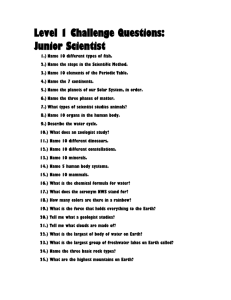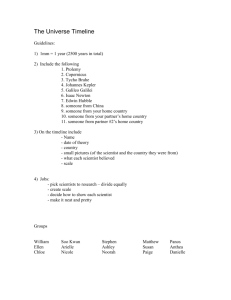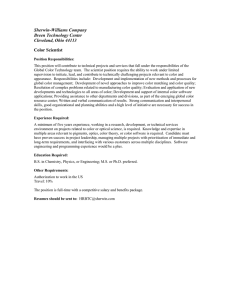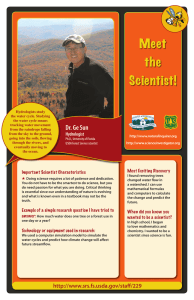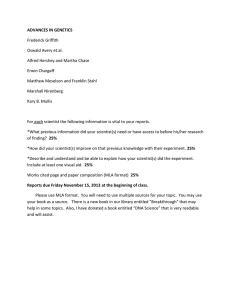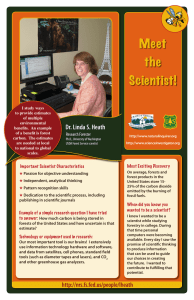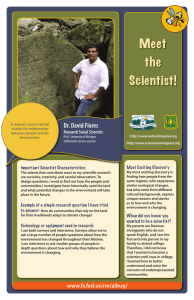Environment
advertisement
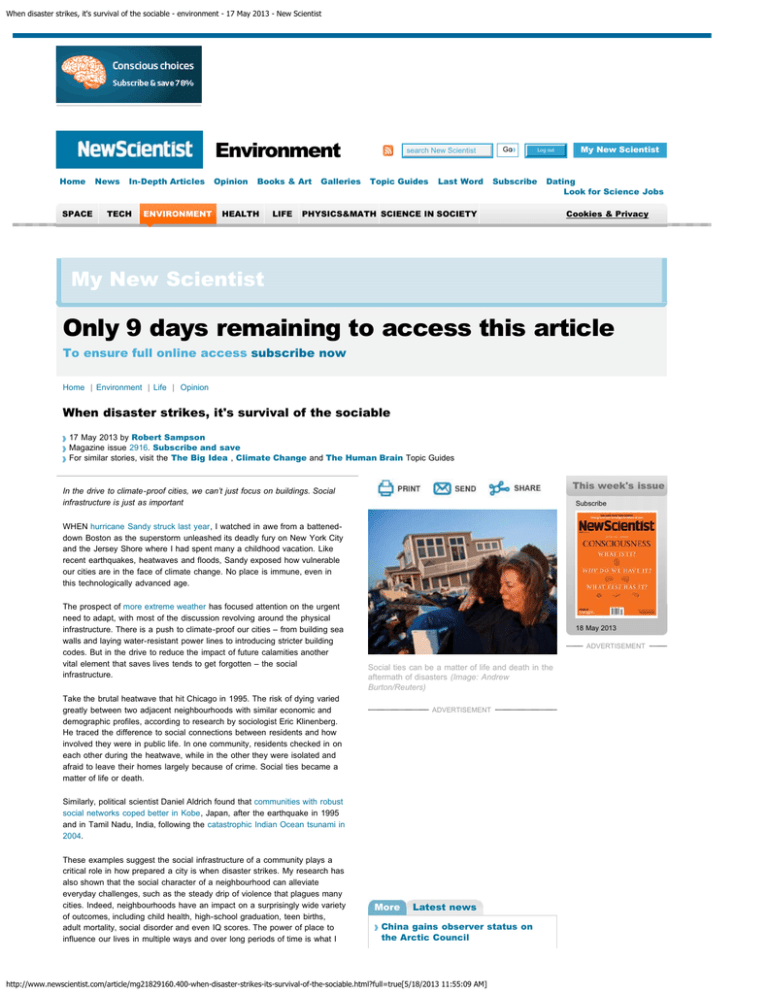
When disaster strikes, it's survival of the sociable - environment - 17 May 2013 - New Scientist Environment Home SPACE News In-Depth Articles TECH ENVIRONMENT Opinion Books & Art HEALTH LIFE Galleries search New Scientist Topic Guides Last Word Go Subscribe Log out My New Scientist Dating Look for Science Jobs PHYSICS&MATH SCIENCE IN SOCIETY Cookies & Privacy My New Scientist Only 9 days remaining to access this article To ensure full online access subscribe now Home | Environment | Life | Opinion When disaster strikes, it's survival of the sociable 17 May 2013 by Robert Sampson Magazine issue 2916. Subscribe and save For similar stories, visit the The Big Idea , Climate Change and The Human Brain Topic Guides This week's issue In the drive to climate-proof cities, we can’t just focus on buildings. Social infrastructure is just as important Subscribe WHEN hurricane Sandy struck last year, I watched in awe from a batteneddown Boston as the superstorm unleashed its deadly fury on New York City and the Jersey Shore where I had spent many a childhood vacation. Like recent earthquakes, heatwaves and floods, Sandy exposed how vulnerable our cities are in the face of climate change. No place is immune, even in this technologically advanced age. The prospect of more extreme weather has focused attention on the urgent need to adapt, with most of the discussion revolving around the physical infrastructure. There is a push to climate-proof our cities – from building sea walls and laying water-resistant power lines to introducing stricter building codes. But in the drive to reduce the impact of future calamities another vital element that saves lives tends to get forgotten – the social infrastructure. 18 May 2013 ADVERTISEMENT Social ties can be a matter of life and death in the aftermath of disasters (Image: Andrew Burton/Reuters) Take the brutal heatwave that hit Chicago in 1995. The risk of dying varied greatly between two adjacent neighbourhoods with similar economic and demographic profiles, according to research by sociologist Eric Klinenberg. He traced the difference to social connections between residents and how involved they were in public life. In one community, residents checked in on each other during the heatwave, while in the other they were isolated and afraid to leave their homes largely because of crime. Social ties became a matter of life or death. ADVERTISEMENT Similarly, political scientist Daniel Aldrich found that communities with robust social networks coped better in Kobe, Japan, after the earthquake in 1995 and in Tamil Nadu, India, following the catastrophic Indian Ocean tsunami in 2004. These examples suggest the social infrastructure of a community plays a critical role in how prepared a city is when disaster strikes. My research has also shown that the social character of a neighbourhood can alleviate everyday challenges, such as the steady drip of violence that plagues many cities. Indeed, neighbourhoods have an impact on a surprisingly wide variety of outcomes, including child health, high-school graduation, teen births, adult mortality, social disorder and even IQ scores. The power of place to influence our lives in multiple ways and over long periods of time is what I More Latest news China gains observer status on the Arctic Council http://www.newscientist.com/article/mg21829160.400-when-disaster-strikes-its-survival-of-the-sociable.html?full=true[5/18/2013 11:55:09 AM] When disaster strikes, it's survival of the sociable - environment - 17 May 2013 - New Scientist call the "enduring neighbourhood effect". Over the last two decades, I have investigated the science of how cities and their neighbourhoods work, using Chicago as an urban laboratory. My research team and I followed more than 6000 families wherever they moved, as well as studying the city's neighbourhoods themselves. We surveyed more than 10,000 residents, watched video footage we took of thousands of city streets, assessed the social networks of community leaders and gathered data on collective civic events such as fundraising for schools and blood donation. We also fielded a "lost letter" experiment to find out the rate at which strangers mailed back stamped letters we dropped in the streets, and calculated the percentage of people having a heart attack in a neighbourhood who received CPR from bystanders. In five communities, for example, no lost letters were returned, but in others nearly the opposite was true. This information was combined with records on crime, violence, health, community organisations and population characteristics over 40 years. 17:01 16 May 2013 The Arctic Council has admitted five Asian nations – most notably China – plus Italy as observers. What does this mean for the Arctic's future? Ice tsunamis overwhelm lakeside homes 12:09 16 May 2013 It's a rarely seen phenomenon – high winds have blown ice floes ashore in Canada and the US on two consecutive days, destroying homes Rebuilding not rewinding is the future of conservation 09:00 16 May 2013 A key factor we identified that differentiated some neighbourhoods from others was the extent of social cohesion among residents and their willingness to intervene on behalf of the common good – we called this "collective efficacy". Our measurement strategy was to ask residents how likely their neighbours were to take action in various circumstances – for example, if a fight were to break out. We also asked about local trust and how willing residents were to help their neighbours. Even after accounting for poverty and kinship ties, collective efficacy was directly related to lower rates of violence, teenage pregnancy and social disorder within the community. Our research is part of a larger effort to develop tools to measure and evaluate the social-ecological infrastructure of cities, known as "ecometrics". This can be directly applied to disaster planning. Cities can use ecometrics to identify and support not only those neighbourhoods that are physically vulnerable, but also those that lack a resilient social infrastructure. Emergency response When disaster strikes, consider the collective actions that can be taken. Who has a power generator and is willing to share with others? Who wants to volunteer and where? Who has extra food or will take in a neighbour for shelter? These questions strike at the heart of a community's capacity to respond in times of crisis. These disaster responses may determine survival, and we can measure the likelihood of them happening. The evidence from Chicago also provides clues to the kinds of structures that should be nurtured. The more community groups in an area, the greater the collective efficacy, social altruism and collective civic engagement. The prevalence of such organisations even seemed to predict which vulnerable neighbourhoods were best able to stem the number of houses being repossessed as a result of the economic recession. The concept of "natural" makes little sense in our ever-changing, human-dominated world World's fish are migrating to escape global warming 18:00 15 May 2013 A new survey shows that around the world, the fish caught in local nets are increasingly adapted to warmer waters see all related stories Most read Most commented Pain ray: The US military's new agony beam weapon Zap the brain with electricity to speed up mental maths Ghostly pictures made in 3D – minus the camera Google and NASA buy controversial quantum computer Ice tsunamis overwhelm lakeside homes TWITTER New Scientist is on Twitter Community organisations provide more than advice and material resources – shared expectations and trust are enhanced by coordinated activities, whether they are run by neighbourhood groups, tenant associations or afterschool centres. In the aftermath of Sandy, the efforts of neighbours to band together and provide mutual aid in the isolated Rockaways neighbourhood of New York were coordinated by a beach club. This makes sense: organisations generate a web of routine activities and associations that lubricate collective action, although they are seldom planned as such. What is important is not the existence of any specific type of organisation but the overall organisational infrastructure of a community and overlapping networks among participants. Technology can also help bring neighbours together for a common purpose. Contrary to prevailing assumptions, there is evidence that the boom in social media that connects users globally may have simultaneously increased local connections. In many cities, citizens use their smartphones to report on their neighbourhood's physical infrastructure – potholes and light outages, for instance – and potentially, on its social structure. Some organisations and city governments use the web to encourage local civic engagement, and companies like nextdoor.com have built platforms for neighbourhood social networks. The lesson is that crises are mediated by the social as well as the built environment. Qualities such as the shared willingness to intervene and civic engagement constitute a social resource that helps explain the well-being of communities – in good times and bad. We can measure these qualities and monitor efforts to build and sustain their sometimes fragile hold. Just as Get the latest from New Scientist: sign up to our Twitter feed LATEST JOBS Paramount Recruitment: Medical Writer / Editor - LONDON Northpoint Recruitment: Junior Analytical Technician SEC Recruitment: Clinical Research Associate ( CRA; SCRA; Lead CRA) Paramount Recruitment: Senior Account Director - Healthcare Advertising Paramount Recruitment: Account Manager - Medical Communications http://www.newscientist.com/article/mg21829160.400-when-disaster-strikes-its-survival-of-the-sociable.html?full=true[5/18/2013 11:55:09 AM] When disaster strikes, it's survival of the sociable - environment - 17 May 2013 - New Scientist humans need social connections as well as physical resources to survive and thrive, so too do communities. Research on neighbourhood effects provides a framework for readying our cities for weather disasters of the future. This article appeared in print under the headline "Survival of the sociable" Profile Robert J. Samson is professor of social sciences at Harvard University. In 2011, he won the Stockholm prize for research showing why criminals stop offending. His book, Great American City: Chicago and the enduring neighborhood effect, is out in paperback this month From issue 2916 of New Scientist magazine, page 28-29. As a subscriber, you have unlimited access to our online archive. Why not browse past issues of New Scientist magazine? Like Like 0 If you would like to reuse any content from New Scientist, either in print or online, please contact the syndication department first for permission. New Scientist does not own rights to photos, but there are a variety of licensing options available for use of articles and graphics we own the copyright to. Have your say Only subscribers may leave comments on this article. Subscribe now to comment, or link your account to an existing subscription. All comments should respect the New Scientist House Rules. If you think a particular comment breaks these rules then please use the "Report" link in that comment to report it to us. If you are having a technical problem posting a comment, please contact technical support. Back to top Log out Go search New Scientist About us User Help Subscriptions Links Science Jobs New Scientist Syndication Recruitment Advertising Staff at New Scientist Advertise RBI Jobs Contact Us FAQ / Help Disclaimer Ts & Cs Cookies Privacy Policy Subscribe Renew Gift subscription Back issues Customer Service Site Map Browse all articles Magazine archive NewScientistJobs The Last Word RSS Feeds Online Store Android App Mobile site home Biology Jobs Chemistry Jobs Clinical Jobs Sales Jobs Earth & Environment Jobs Engineering Jobs Maths & IT Jobs Graduate Jobs © Copyright Reed Business Information Ltd. http://www.newscientist.com/article/mg21829160.400-when-disaster-strikes-its-survival-of-the-sociable.html?full=true[5/18/2013 11:55:09 AM]
